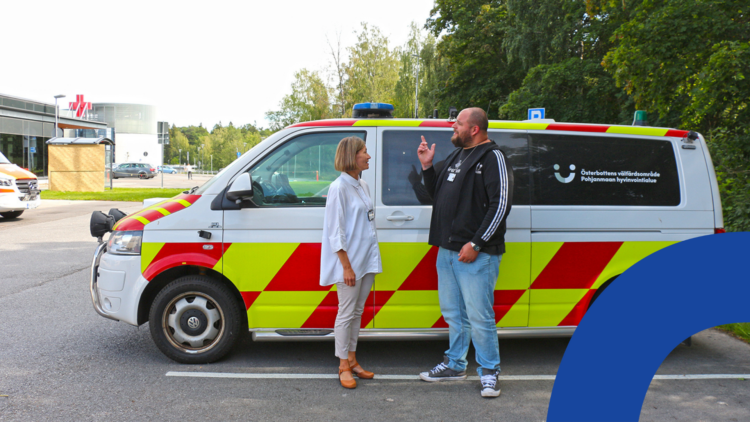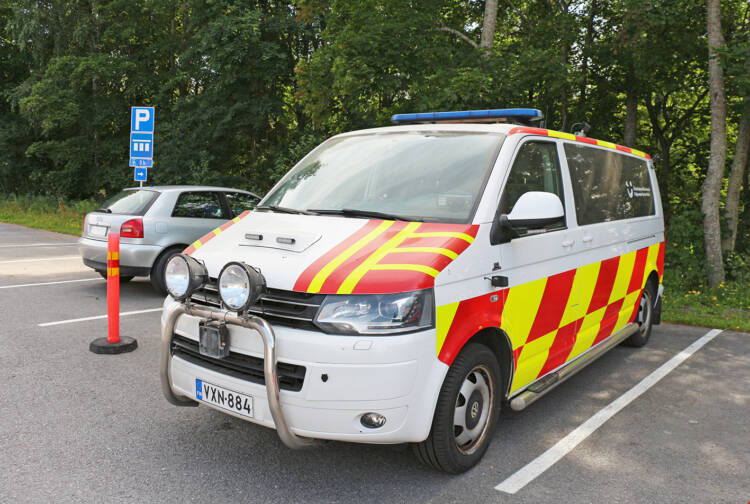Introduction of new services to support the care of seniors

A new way of working will be tested in the Wellbeing Services County of Ostrobothnia during the autumn, which is aimed at bringing emergency healthcare services closer to the residents of the wellbeing services county. The process consists of a new mobile unit belonging to the joint emergency department, as well as an assessment of the need for care made by a paramedic over the phone. This aims to support seniors living at home, in particular, by providing on-call care support to professionals, and contributing to a reduction of the burden placed on the joint emergency department and non-urgent first aid tasks.
– We have been aware of the need for something like this for a long time and I am very satisfied that we have managed to get a project manager to plan the project and the opportunity to test how it actually works. The purpose is to continue planning and to have a broader, multi-professional and permanent operating model that covers the entire wellbeing services county, says the head nurse of the hospital’s emergency care services, Saija Seppelin.
Emergency care at home
Carers working within home care and housing services can call an experienced nurse working as a coordinator within joint emergency care. Based on the call, the coordinator assesses the need for treatment and, if necessary, can drive the treatment provided by the emergency department (A&E) to the patient. In this case, there is no need for an ambulance and the patient does not have to go to a joint emergency department.
The nurse of the mobile unit has the opportunity, for example, to take blood tests where the customer is living. However, the service does not replace first aid. It is important that home care and housing services continue to call the emergency number directly when dealing with an obvious emergency (e.g., a convulsing or lifeless patient).
The mobile unit can provide clients with care that would otherwise require a visit to the emergency department. Such care includes, for example, intravenous antibiotic treatments and wound dressings. – The treatment is planned and implemented with the help of a remote connection, in close cooperation either with the customer’s own doctor in charge or with the doctor of the joint emergency department. Treatment given at home can still be continued by the At-home hospital, says project manager Vesa Aro.

A crowded emergency department can cause extra stress
According to research, there is a risk that keeping a senior person in an emergency department for a long time can lead to a decrease in their functional capacity, which in turn, can cause them extra stress particularly when the department is often crowded. Going from a familiar environment to a hectic, possibly overcrowded emergency department for hours can prolong the recovery process significantly. For this reason, any treatment that can be taken to seniors can even speed up recovery and thus shorten treatment times.
This new way of working will be piloted during the autumn around the City of Vaasa and the municipality of Mustasaari, and the pilot phase will specifically apply to customers of home care and housing services. Other citizens are not covered by the service in the initial phase.
– We will continue to develop and plan these activities. The goal is to be able to offer the service to the entire wellbeing services county. This service is only offered outside of office hours, at least during the trial period, explains Seppelin.
First aid help also by phone
In the autumn, a new activity will also be piloted, in which first aid tasks classified as non-urgent by the Emergency Centre are first contacted by phone. An experienced paramedic assesses the need for treatment over the phone, whereby it can be determined whether sending a physical ambulance for the task at hand is necessarily needed.
The paramedic calls the notifier as soon as possible, but no later than within an hour after the Emergency Centre has forwarded the task to the paramedics.
– The aim is to reach non-urgent tasks nationally within two hours of being alerted, so an assessment of the need for care made over the phone will hopefully speed up the handling of non-urgent tasks, says Aro.
The operation covers the entire Wellbeing Services County of Ostrobothnia, from the municipality of Luoto (Swe. Larsmo) in the north to the southern parts of Kristiinankaupunki (Swe. Kristinestad), up to the border of Satakunta.
Currently, the emergency service of the Wellbeing Services County of Ostrobothnia handles approximately 7,000 non-urgent first aid tasks each year (excluding hospital transfers). Non-urgent tasks tie-up the emergency staff to the patient, even though such a patient is often comparable to someone simply requiring healthcare advice. Elsewhere in Finland, it has been observed that an assessment of the need for care carried out on the first aid phone reduces the non-urgent first aid tasks transferred to ambulances by about half.
The assessment of the need for care will be done over the phone in three languages, around the clock, which increases the possibilities of ambulances to handle urgent tasks. The purpose of the activity is to provide advice and guidance in non-urgent situations. In emergency and other unclear situations, an ambulance is always sent to the destination.
– The orientation of both the emergency nurses working in the mobile unit and the first responders who assess the need for treatment over the phone will start at the beginning of September, and activities are planned to start immediately after that, says Aro.